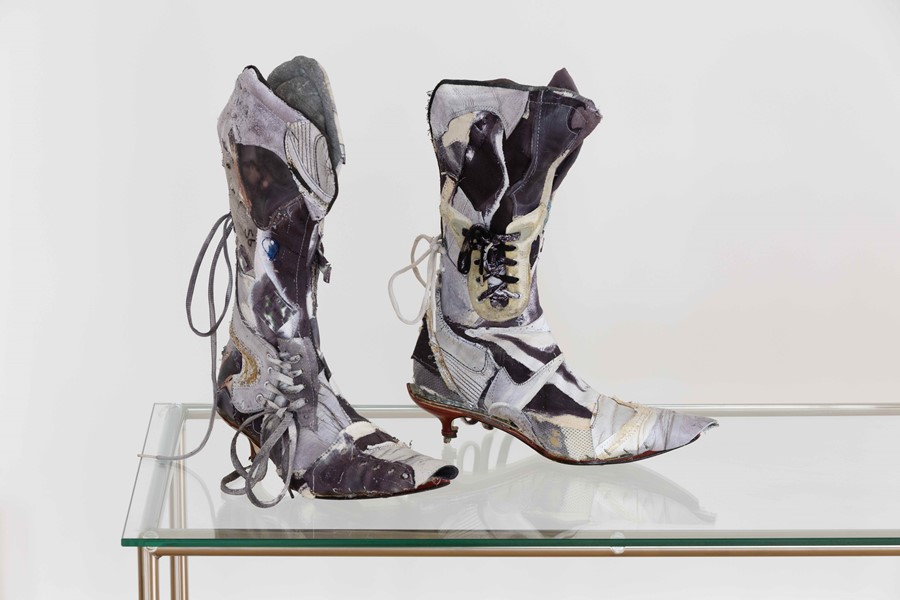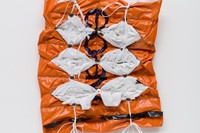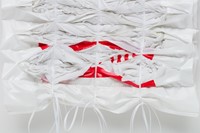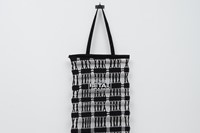As her new London exhibition opens, Tenant of Culture – aka Hendrickje Schimmel – talks about Rei Kawakubo and the thinking behind her radical, deconstructed textile sculptures
Neatly sliced and wrapped packaging bursting at the slits with clothing, unravelled (and then re-ravelled) tote bags, holey knit murals: at Tenant of Culture’s new show Ladder, at Soft Opening in London, the objects and aesthetics feel familiar and foreign at the same time. Displaced, destroyed, deconstructed – these material remnants of our consumeristic behaviours, which are the toxic heart of the fashion industry, are conceived of as sculpture, posing a very real question: why are we so obsessed with destruction as decoration?
Fabricated or “pre-consumer” destruction is the point of tension through which Tenant of Culture continues the exploration of the cognitive dissonance between “the individual relationship that we have with the garments versus the industry in which they are produced.” “I try to really hone in one particular material process and then expand from there,” the artist explains, “looking at certain historical events in relation to that, and then also connecting them to contemporary manufacturing.” By placing contemporary aesthetics – like purposefully destroyed garments which defined last year’s ‘avant apocalypse’ trend à la Balenciaga – within an expansive historical context, Tenant of Culture makes fashion tangible and material, a continuing modality rather than an ephemeral concept.
Tenant of Culture is the name of Netherlands-born designer Hendrickje Schimmel’s artistic practice. With a background in fashion design and textile, including a stint working as an embroidery designer, the art world’s white cube gallery space may seem like an odd resort for someone used to the fast-paced functionality of fashion. “I think trying to address issues in fashion through fashion is very complicated because of the timeframes – the very quick pace and short attention spans,” she says of her choice to exhibit within the realm of art. A gallery provides both space and time: as couture becomes sculpture, the observer can digest the multidimensionality of the problems Tenant of Culture is tackling. “But I still see myself as a fashion practitioner,” she adds, “because all my research is in the history of design, fashion, and manufacturing.”
Ladder is divided into three parts, each addressing different conceptions of destruction in the manufacturing process. Haul is a series of assemblages in which soft fast-fashion packaging is lattice-sliced to reveal bursts of second-hand garments. “It refers back to the slashed sleeves of the Swiss Mercenary Army in the early Renaissance,” Schimmel explains. “Underneath their fighting costume, they would wear bright silks. Their tattered costumes would then expose this lining.” This trend was replicated by the European aristocracy, imitating through style the heroism of the young soldiers.
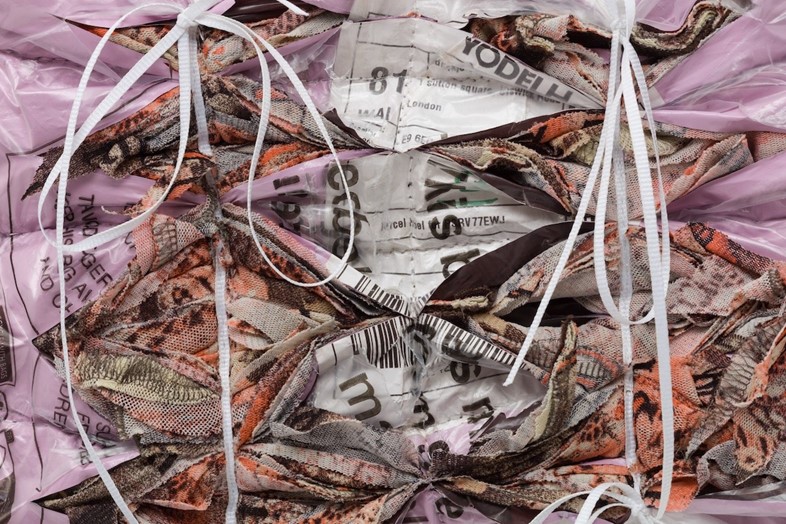
Drawn taps into her knack with textiles as the threads of tote bags. The plastic bag of our times are picked apart and then rewoven using open work embroidery. The result is a lace-like tapestry with the tote’s branding disfigured into abstract imagery. The final series, Sabotage in Acrylic, similarly considers destruction through craft. Stretched across the gallery space, the holey knitted mural, created in collaboration with knitwear designer Ilana Blumberg, calls to mind perhaps the most famous of destroyed garments: Rei Kawakubo’s drop-stitched sweater ‘Holes.’ “It does actually connect to how Kawakubo sabotaged her own machinery,” says Schimmel. “Sabotage comes from the French word saboteur which refers to the sabots, a type of clog worn by labourers.” To stabilise wages, these clog-wearing labourers would destroy machinery – an early form of trade unionism. “It’s really funny that sabotage initially started off as something that labourers did in order to kind of have a negotiating position,” she adds, “and then it becomes aestheticised as a look. I find that tension quite interesting.”
Tenant of Culture’s exhibition is accompanied by a long-format essay by design historian Eilidh Duffy, which expertly weaves together the multitude of references hidden throughout Ladder. But even on their own, the works push us to consider fashion as more than static garments to be consumed within trend cycles. Rather, it adds texture to our daily wear by shedding light on the technical journey each piece has endured before it reaches our wardrobe. And when placed in the context of history, we realise that ‘newness’, the fuel of contemporary consumerism, is just a fiction after all.
Ladder by Tenant of Culture is on show at Soft Opening in London until 21 October 2023.
